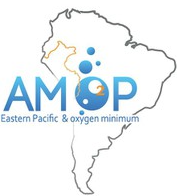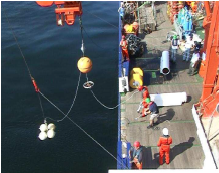In order to document i) the O2 OMZ structure, ii) the physical O2 contribution (advection/diffusion), and iii) the biogeochemical O2 contribution (consumption/production), the AMOP global work strategy is based on 3 main components:
1) A process-oriented cruise of ~30 days involving the ship L’Atalante from IFREMER that focuses on 8 fixed stations of 2-3 days duration and on 28 other hydrological stations along a rectangular box parallel to the Peru coast. Cross-shore transects at 7°S, 12°S, and 14°S has been also done. Ultra-low O2 concentrations and organic matter has been carried out where all experiments (bacteria, zooplankton, organic matter/particles degradation) are based on incubation approaches using isotopic and molecular techniques and innovative micro-sensors or equipments. Clean experimental work on microbial processes based on C14 and H3 components has been performed in a container for radioactive manipulation. 9 Argo floats including optodes (O2) have been deployed at stations offshore along the 3 cross-shore transects. The floats will document part of the lateral advection of O2 associated with the mesoscale structures on a larger spatio-temporal domain.
2) A subsurface mooring at a fixed station on the 12°S historical radial, being the reference station for a high temporal resolution monitoring of the OMZ structure. The mooring was deployed on the 5th January 2013 and recovered on the 26th of February, 2014.
3) A high-resolution physical/biogeochemical coupled modeling platform providing the support for the interpretation of the whole AMOP data set (from in vitro to in situ and satellite and proxy data) and which will allow bridging the gap between sampled and non-sampled spatio-temporal scales. The coupled modelling platform is based on the ROMS physical model at various resolution depending on domains (1/12°, 1/36°, 1/108°) coupled with a biogeochemical (BioEBUS) model.



